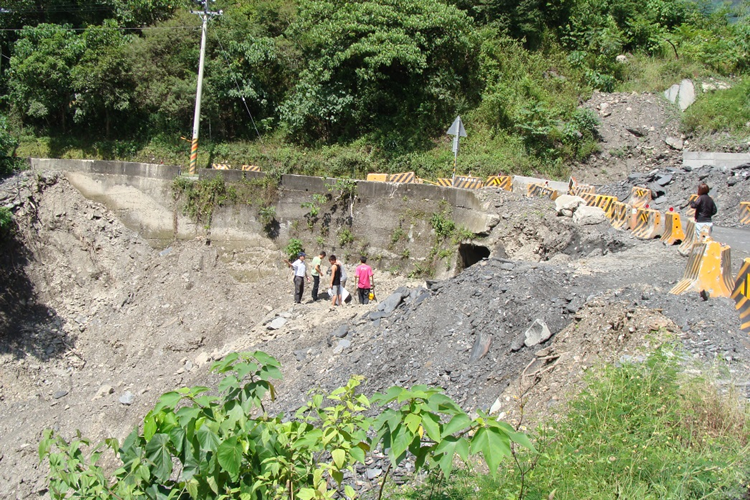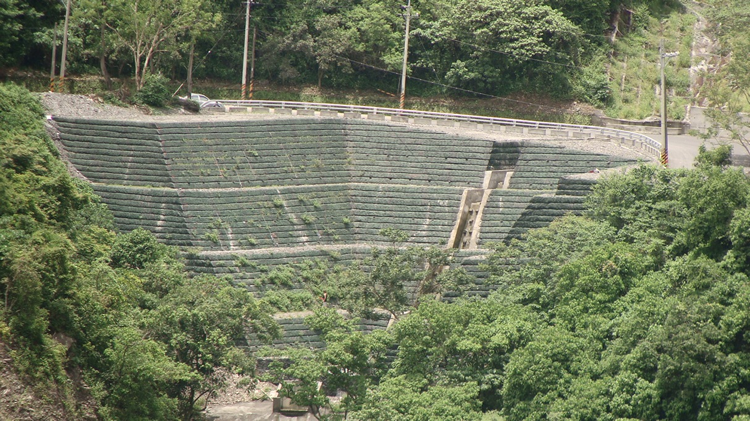
By ACE Geosynthetics – In 2009, Typhoon Morakot hit central and southern Taiwan with torrential rain. The storm set a rainfall record and was responsible for numerous disasters, such as landslides and dike failures. More than 100 bridges were damaged and mountain roads collapsed.
Failure of Route Kao 132
Route Kao 132 in Kaohsiung is an important tourism and commercial road. It is the only access road for the Purple Crow butterflies forest area and the Dona hot springs. (Like the Monarch butterflies in North America, the Purple Crow Butterflies are unique in that they are migratory.) It is also an essential route for many aboriginal people who live in this fairly isolated region.
Taking into account the livelihood of the local residents, immediate road reconstruction was urged.
Typhoon Morakot brought a rainfall of 1400mm (55 in.) to the region in just four days. The failed road and slope section just did not have the drainage capacity to manage such an intense and excessive volume of water. The rainwater flowed along the down side slope of the road, saturating it and causing collapse.
Slope Reinforcement

The failed section was more than 20 m (65 ft.) long and 100 m (328 ft.) wide. It occurred at a curve in the road, and to contain project costs and land disturbance, it was decided that the slope rebuild would best follow the pre-existing road curvature.
This meant that any solution would have to allow a varied alignment.
A traditional reinforced concrete structure was considered as a rebuild option, but it was deemed too expensive and would require a great deal of time to construct.
The design team chose to build a geogrid-reinforced structure. A wrap-around (or, envelope) method was selected as an economical, high-strength repair for the slope and road. This solution would allow the reuse of site soils and construction could fit safely within the pre-existing bend in the road and hillside.
A four-terraced reinforced slope was designed, with each step set at 5 m (16 ft.) high and at an angle of 1:0.5. The overall height of the structure was 20 m.
ACEGrid® GG150-I and GG100-I were applied as the main reinforcement materials.
Additionally, the reinforced slope was supported by 2 m of a reinforced concrete foundation. Gabions were installed in front of the foundation to guard the slope toe from rain erosion.
In order to improve the drainage capacity of the road and reduce the water content of the geogrid wrap-around slope, a large, longitudinal drainage ditch was built close to the center of the reinforced slope and connected to the horizontal ditch at each elevation.
Moreover, intensive internal drainage materials were installed in the reinforced soil mass.
The wrap-around geogrid system allowed for grass planting along the slope surface. The growth of vegetation would help guard against soil erosion and water infiltration.
Deformation Monitoring
In order to monitor and study the deformation behavior of this structure after completion, the client requested the installation of a monitoring system. Three in-place inclinometers were installed inside the structure to monitor the sliding behavior of the slope.
Additionally, strain gauges were adhered to geogrids at four elevations on the same profile to study the stress-strain behavior of the reinforced material.
Renewed Habitat
The decision to use a geogrid-reinforced design instead of a traditional reinforced concrete one enabled a shorter construction window and saved cost. And local soils were able to be used, further improving the project economics and the overall eco-friendliness of the construction activities.
Today, the rebuilt slope section of Route Kao 132 is covered by vegetation—which has added habitat for the Purple Crow butterflies.
About ACE Geosynthetics (ACE)
ACE manufactures and supplies a wide range of quality geosynthetic products for various engineering fields. Products such as geotextiles, geogrids, and geotextile tubes are sold worldwide for geotechnical, transportation, environmental, and hydraulic applications. In addition, ACE offers comprehensive technical service to assist customers during the procurement and construction process.
ACE Geosynthetics has devoted its time and effort to quality building. In addition to achieving an ISO 9001 certified quality management system, ACE has obtained various verifications and approvals for its products.
For more information about ACE geogrids or this project, please contact sales@geoace.com or visit www.geoace.com.











